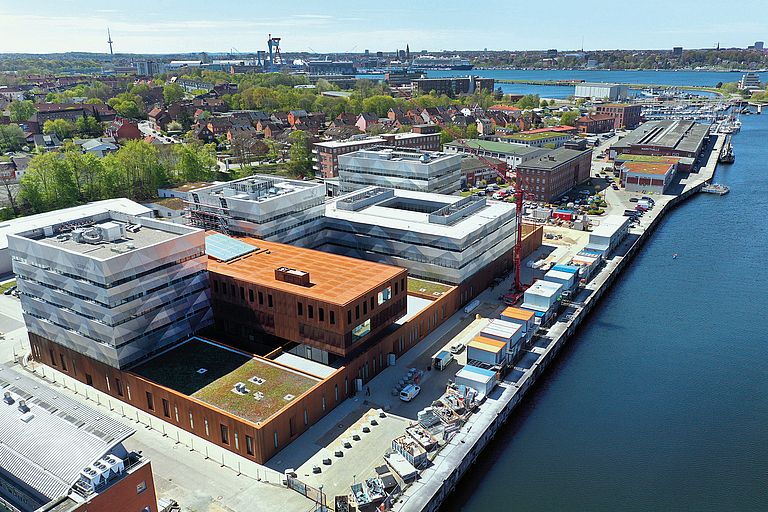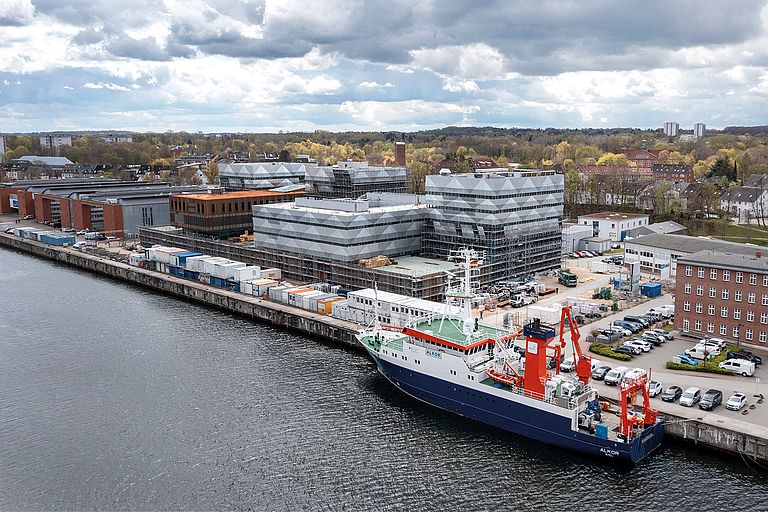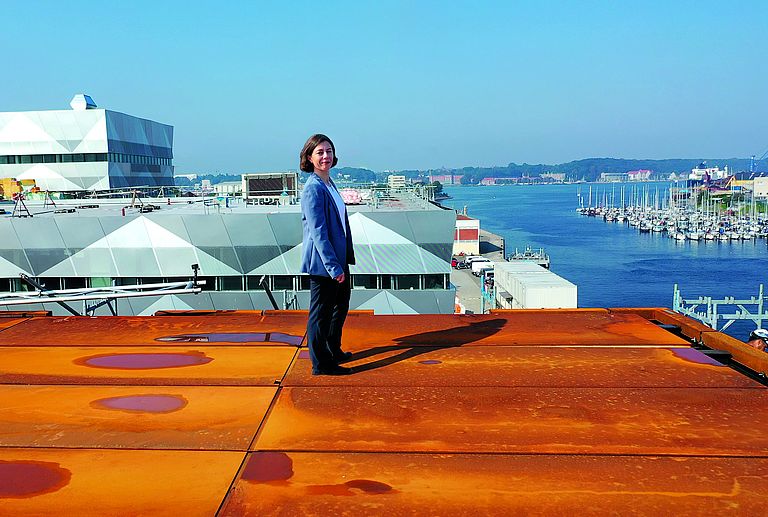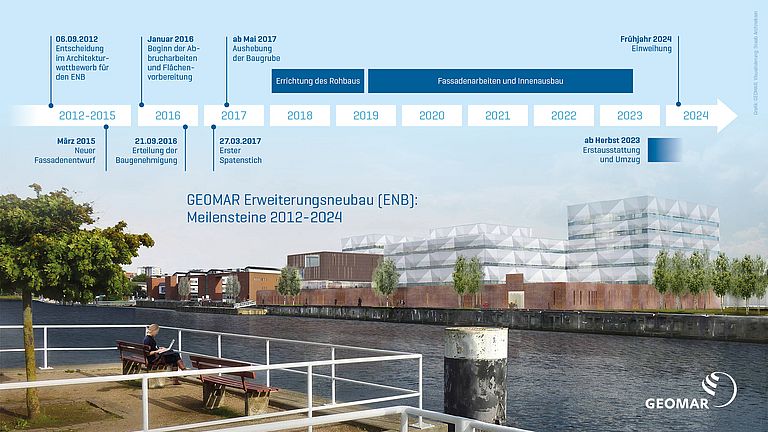A new lighthouse for marine research
As of September 2023, GEOMAR’s new building unites all four research divisions
“We are happy and proud to be able to move into our new building from this autumn after almost two decades of preparations and planning, seven years of construction and several delays,” says GEOMAR Director Professor Dr. Katja Matthes. “The joint research at GEOMAR benefits from interdisciplinary collaboration.”
With the start of the move in September, a project planned for almost 20 years ago will become reality: Four research divisions, administration and central facilities will be able to cooperate more easily and with greater focus across marine science disciplines according to the GEOMAR strategy at one location. In addition, researchers will benefit from the modern infrastructure with various laboratories, climate chambers and the seawater pipeline as well as the conference area, library and computing centre. The building designed by Staab Architekten GmbH will make an impression far beyond the state capital of Kiel – a new lighthouse for marine research.
“More than ever, we will be able to harness our expertise for marine research under the proverbial ‘common roof’. The new building takes this into account with modern infrastructure and enables direct exchange. A unique marine science campus develops at the Seefischmarkt. In this inspiring and excellently equipped environment, we continue to pursue our mission to understand the ocean and its functions and to contribute to its protection and preservation for future generations,” Director Matthes continues.
The idea of merging the two locations was already present in 2004 when the Leibniz Institute of Marine Sciences IFM-GEOMAR was founded from the Institute of Oceanography (IfM) and the Research Centre for Marine Geosciences GEOMAR. However, the change from the Leibniz to the Helmholtz Association required a new start to the planning process. Finally, in 2012, an architectural competition was launched, and Staab Architekten GmbH convinced the jury with its design. With the robust corten steel base and the five three- to five-storey cubes on top of it, the ensemble they designed follows the shape of a ship. The characteristic façade elements made of aluminium and glass are reminiscent of boat sails and reflect the maritime atmosphere.
The total cost of the project, which was originally planned and launched on a much smaller scale, is currently estimated at 138.200 million euros (net). In addition to the new extension building, the project also includes the new construction of the Core and Rock Repository, the parking facility with the bicycle parking garage, the seawater intake system from the Naval Arsenal to GEOMAR and parts of the initial equipment. The costs are divided 90 percent by the federal government and 10 percent by the state of Schleswig-Holstein.
On 22 June 2015, the building permit for the Core and Rock Repository and the parking facility was granted, followed by the building permit for the new extension building on 21 September 2016. The groundbreaking ceremony for the new building was celebrated on 27 March 2017. On 28 September 2019, the Core and Rock Repository and the car park were inaugurated. A setback was caused by a fire that broke out during roof work on 13 September 2022, which required renovation work on the façade and some interior rooms even before the move could be made.
“The Corona pandemic caused bottlenecks in the supply of building materials and, due to contact restrictions and other precautionary measures, in construction activity. As a result of Russia's attack on Ukraine, costs for some material as well as energy for the building increased. Finally, there was the fire, which fortunately did not harm anyone, but required extensive renovation work even before the move,” summarises Frank Spiekermann, Administrative Director of GEOMAR. “In view of these circumstances, we are all the more relieved to be able to carry out the move from September onwards and ultimately officially inaugurate the building in the spring.”
Facts about the new extension building
- 5 towers, total length 128 metres, total width 63 metres, height up to 26 metres
- Total area: 30,000 square metres
- Usable area: 15,476 square metres
- 19 conference and meeting rooms for 11 to 200 people
- 230 offices for about 500 employees
- 166 laboratories and 18 climate chambers
- Seawater pipeline: 1,400 metres
- Seawater basin: 200 cubic metres
- 2 berths for research vessels
- Public library
- Computer centre
- Submersible JAGO in the foyer (built in 1989, operated at GEOMAR from 2006 to 2021)
Facts about the Core and Rock Repository
- Storage area: 1,550 cubic metres
- Floor space: 900 square metres
- Sediment core capacity: 40 kilometres
- 2 cooling cells for frozen samples (-20°C)
- 1 sampling laboratory
- 1 office room

Aerial view of the new GEOMAR building from May 2023. Photo: Sarah Kaehlert, GEOMAR

Aerial view of the new GEOMAR building from May 2021. Photo: Jens Klimmeck, GEOMAR

GEOMAR Director Professor Dr. Katja Matthes on the roof of the new extension building. Photo: Jens Klimmeck, GEOMAR

Zeitstrahl zur Entwicklung des GEOMAR-Neubaus. Grafik: Christoph Kersten, GEOMAR


